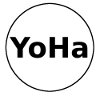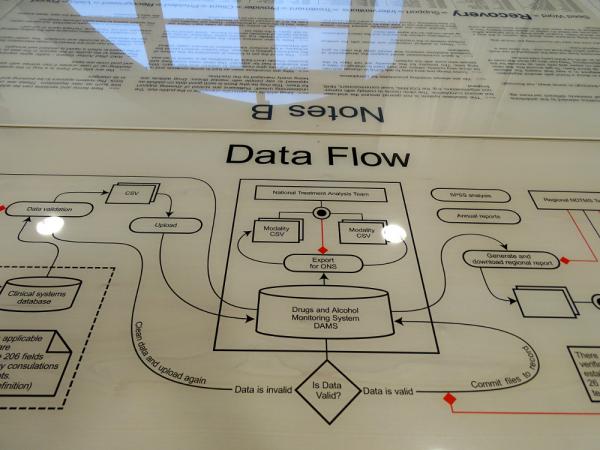
Critical Friends

Introduction:
Lorraine Hewitt House is situated in the heart of Brixton, it is staffed by busy and engaged drugs workers, clinical psychologists, social workers, psychiatrists and administrators including reception staff and all have a high work load. The care-centre sits at the nexus of several databases National Drug Treatment Monitoring System (NDTMS), Electronic Patient Journey System(EPJS ), NHS Spine etc. The enterprise of the care-centre in it's own words is to “support anyone over the age of 18 with alcohol or drug problems who lives in Lambeth. Providing a key worker to a service-user working with them to formulate a care plan for a journey through other services.”
The project has two phases: To work within the care-centre to explore the culturalisation of databases from the perspective of staff, management and the second phase is to put forward the proposition of building a database from the perspective of service-users. (as yet not started)
The first phase has begun by talking with drugs workers, clinical psychologists, social workers, and administrators including reception staff. We have as yet had no contact with the psychiatrists who on current appearance seem to command a particular aloof status within the building. We have documented conversations about how databases inform the working practices and inter-relationships between different components that make up the The Lambeth Addiction Treatment Consortium, South London & Maudsley NHS Foundation situated at Lorraine Hewitt House.(care-centre)
The afore mentioned objectives are structured to explore the culturalisation of the technical objects that in/form the workings of the care centre. Another way to think about this is the space where the abstraction of the database models conjoins with the action of individuals and become an inheritable workplace culture. This cultural space is where we imagine ourselves operating.
To open this subject up we can think about how the enterprise of 'addiction care' consists of multiple enterprises at different scales. Most people work with the Electronic Patient Journey System which has background processes, sorting algorithms that extract information into other systems such as the National Drug Treatment Monitoring System whose enterprise is summarised as: 'process information from and for those involved in and around the governance of drug treatment.'
The term enterprise is used to describe a domain of actions that take place in relation to the building that are interrelated to collections of information, taxonomies, ontologies, that evidence decisions, events and result in quantifiable structures that reciprocally create other individual actions. Enterprise is also a convenient way through which the research team can describe the structural coupling of databases and the intention of the care-centre. The purpose if you will of the socio-technical and architectural structure. Databases are more often then not regarded as a technical solution with scant regard is given to their culturalisation, sociality or the way the knowledge/power, or architectural relations are altered by them.
“Drug addicts are generally unpopular in the public eye - “the undeserving sick”. Politicians seem scared to showing support for them. This may be why there is such good data on addicts as opposed to say people with mental illness.”
One possible method to think through how the agency of databases might be interrelating with the enterprise and individuals in the care-centre is to speculate on how the agency might operate in relation to the lives of individuals rather then in relation to legal structures. This proposition has two interrelated domains; discipline(compliance) and governmentality. Discipline in this context operates institutionally and on particular individuals in the particular space of the care-centre. Information is collected about individuals and actions are invoked according to that information. This notion of discipline acts on the lives of staff and at the same time operates on the lives of service users and should not be differentiated as it is part of the same machine.
“The system is not geared around the end user but around compliance. The clinic needs to comply with numerous organisations eg “the sequins”(?), local commissioners, Public Health England.”
Governmentality, on the other hand, operate on particular #groups of individuals. It receives information through statistical analyses, financial reports and population registers. Its techniques of power are directed to making adjustments in the population and their economic condition. Legislation is one technique which is used to make these adjustments. It works alongside the other governmental devices which can be thought of as policing the population.
What is articulated in the databases about addiction
The databases used in the care-centre are many and varied as the care-centre is at the nexus of clinical, social, legal, governmental modalities. There are many entry points to this database nexus NDTMS, EPJS, NHS Spine. Each offers it's own lens on governance and knowledge/power relations. As an example the Core Data Set (CDS) of the The National Drug Treatment Monitoring Service (NDTMS) structure unlocks what is articulated about addiction from an idealogical, technical, political, bureaucratic or governmental viewpoint which is used amongst other things for monetising addiction services.
Differing roles with the care-centre structure afford different views of the databases. The NDTMS is largely seen from an administration and managerial view point. It attracts comments such as “It’s difficult to make the metrics relevant to the clinic” Staff member In many ways the NDTMS can be thought to perform a governmental discipline. “These compliance targets need to be logged and are automatically part of the framework - “mandatory field completions” Staff member
These logics interrelate through discipline/compliance through such mechanisms as The Treatment Outcomes Profile (TOP) which purportedly “measures change and progress in key areas of the lives of people being treated in your drug and alcohol services.” This form of compliance affects funding, job security and policing staff efficiency.
The NDTMS can be thought of as diagram that is coextensive with the concrete assemblages, individuals working in addiction treatment centres, medical discourses, laws, politicians, software companies to name but a few that execute it relations. The core data set of the NDTMS can be seen as pointers to a fluid formation of power that is a strategy in action. While this formulation can be useful in understanding this strategy as a navigable fluid architecture it tells us very little about how individuals manipulate the modalities it creates.
To sumerise how we might possible think about NDTMS more as an abstraction without any particular use, an ambiguous figuration of monitoring itself. The abstraction removes the materiality from the object of addiction creating a different modes of action by it's very remoteness from the subject. The ambiguity of purpose itself would have everyone running around trying to feed it what they imagine it wants/needs. Ambiguity will make the database interact on with the structures of delivery, the materiality from which it was derived.
Another way to think about NDTMS is to imagine it was constructed as ambiguous diagram, a sketch of relations and a technical machine. A theatre for the performance of power with a capability to insight, provoke, to compare and combine what ideology can articulate about addiction that is coextensive with creating new knowledge. A kind of abstract R&D that points to the kinds of control governance might find ideal but has not mastered yet. So the NDTMS could be an diagram of its own ambiguity a laying out of what governance cannot see but would like to determine. Worth thinking about how the performance of power produces reality before it represses.
What is visible about addiction to key workers
In fear of stating the obvious, the relational structure of databases are a form of list architecture that produce an abstraction of the care-centre modalities. They afford methods by which the materiality of the care-centres work can be managed and governed at multiple scales from with computation. This process of abstraction while allowing distance and overview from the gritty work of dealing with addiction also by necessity is always incomplete and structurally flawed representation of the experience of the care-centre.
Clinicians, and other front line staff have recounted how what is articulated within the data differs from to what is visible to them about addiction.
“Sometimes when you know these people, it’s not what they are telling you, it’s what they are not telling you.” Interview with staff
Staff recounts several incidents in which situated knowledge of working in this area have revealed errors in provided information, such as whether service users look after children [a point that may be omitted by service-users through fear of state intervention against looking after children]. In these incidents, the information is passed on to other key workers when it has not been recorded in the EPJS.
Staff discuss how the data, then, fails to tell the story in completeness, and how a more accurate or situated comprehension of a “patient’s journey” also involves and requires the understanding situations revealed through testimony and everyday knowledge.
The visibility outside of the database logics, as above can be thought of as situated knowledge that is brought about through individual action building into experience at the centre.( we have been referring to this in our conversations as the art of what someone does)
The space between what is articulated and what is viewable is probably the most contentious issue in relating to the machinery of care delivery and one that has no simple resolution and we have no immediate ideas how to create a space in which this can be explored. How power is performed and contested, resisted, outwitted within the centre is relative within each individual and seems to based on a constellation of personal ethnics and deliberations. This is a fascinating area and one the team will try to give more thought to.
 bnr#23 => Tantalum Memorial, Manifesta7, Alumix, Bolzano, Italy.
bnr#23 => Tantalum Memorial, Manifesta7, Alumix, Bolzano, Italy.